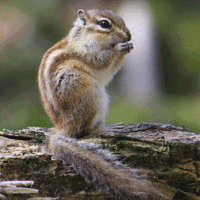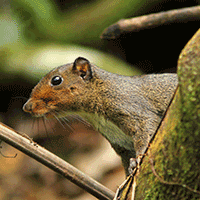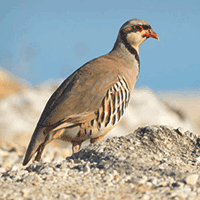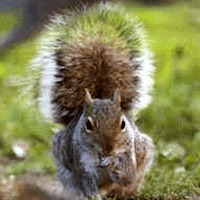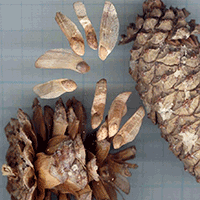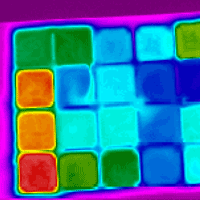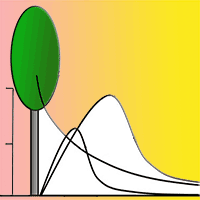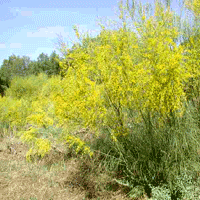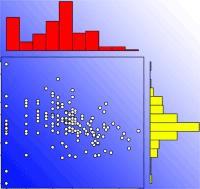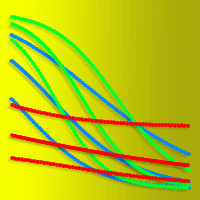Seed traits affect seed dispersal by animals. However, the combined role of seeds and dispersers in determining seed dispersal is not well explored. We attempted to test how seed traits and predators determine seed dispersal and predation interaction in a rodent-mediated seed dispersal system. Semi-natural enclosure experiments were conducted to investigate seed dispersal and predation of five sympatric tree species with different seed traits, Juglans mandshurica, Quercus mongolica, Pinus koraiensis, Corylus mandshurica and C. heterophylla by three rodent species, Apodemus peninsulae, Tamias sibiricus and Clethrionomys rufocanus showing different body sizes, hoarding behaviors and activity rhythms. Our results demonstrated that seed species with thick coat were removed more slowly than thin-coated seeds in regardless of rodent species, reflecting a consistent negative effect of seed coat on seed dispersal. Seeds with thick coat were less likely to be eaten both in situ and after removal by small rodents. Seeds with high caloric value were more likely to be larder-hoarded, whereas seed traits showed no influence on scatter-hoarding. Rodent species with large body size tended to eat more seeds in situ, while small-sized rodents preferred to eat seeds after removal. Large-sized rodent species scatter-hoarded more seeds, however, small-sized rodents larder-hoarded more seeds. Seeds with thick coat showed high mutualism but low predation with rodents, while rodents with large size showed low mutualism but high predation with seeds. Our results indicate that both seeds and predators play important roles in determining seed dispersal and predation in the seed-rodent dispersal system.
Keywords
, , ,
Citation
Yi X, Wang Z, Liu C, Liu G (2015). Seed trait and rodent species determine seed dispersal and predation: evidences from semi-natural enclosures. iForest 8: 207-213. - doi: 10.3832/ifor1185-008
Academic Editor
Massimo Faccoli
Paper history
Received: Nov 20, 2013
Accepted: Jun 24, 2014
First online: Aug 28, 2014
Publication Date: Apr 01, 2015
Publication Time: 2.17 months
© SISEF - The Italian Society of Silviculture and Forest Ecology 2015
Open Access
This article is distributed under the terms of the Creative Commons Attribution-Non Commercial 4.0 International (https://creativecommons.org/licenses/by-nc/4.0/), which permits unrestricted use, distribution, and reproduction in any medium, provided you give appropriate credit to the original author(s) and the source, provide a link to the Creative Commons license, and indicate if changes were made.

Breakdown by View Type
(Waiting for server response...)
Article Usage
Total Article Views: 56014
(from publication date up to now)
Breakdown by View Type
HTML Page Views: 45908
Abstract Page Views: 4587
PDF Downloads: 4146
Citation/Reference Downloads: 22
XML Downloads: 1351
Web Metrics
Days since publication: 4133
Overall contacts: 56014
Avg. contacts per week: 94.87
Article Citations
Article citations are based on data periodically collected from the Clarivate Web of Science web site
(last update: Mar 2025)
Total number of cites (since 2015): 17
Average cites per year: 1.55
Publication Metrics
by Dimensions ©
Articles citing this article
List of the papers citing this article based on CrossRef Cited-by.
(1)
Alexander HM, Cummings CL, Kahn L, Snow AA (2001)Seed size variation and predation of seeds produced by wild and crop-wild sunflowers. American Journal of Botany 88: 623-627.
CrossRef |
Gscholar
(2)
Barcelos AR, Bobrowiec PED, Sanaiotti TM, Gribel R (2013)Seed germination from lowland tapir (
Tapirus terrestris) fecal samples collected during the dry season in the northern Brazilian Amazon. Integrative Zoology 8: 63-73.
CrossRef |
Gscholar
(3)
Brewer SW (2001)Predation and dispersal of large and small seeds of a tropical palm. Oikos 92: 245-255.
CrossRef |
Gscholar
(4)
Capece PI, Aliaga-Rossel E, Jansen PA (2013)Viability of small seeds found in feces of the Central American tapir on Barro Colorado Island, Panama. Integrative Zoology 8: 57-62.
CrossRef |
Gscholar
(5)
Celis-Diez JL, Bustamante RO (2005)Frequency-dependent seed size selection on
Cryptocarya alba (Mol.) Looser (Lauraceae): testing the effect of background. Biological Journal of the Linnean Society 84: 137-142.
CrossRef |
Gscholar
(6)
Chang G, Xiao ZS, Zhang ZB (2009)Hoarding decisions by Edward’s long-tailed rats (
Leopoldamys edwardsi) and South China field mice (
Apodemus draco): the responses to seed size and germination schedule in acorns. Behavioural Processes 82: 7-11.
CrossRef |
Gscholar
(7)
Chang G, Xiao ZS, Zhang ZB (2010)Effects of burrow condition and seed handling time on hoarding strategies of Edward’s long-tailed rat (
Leopoldamys edwardsi). Behavioural Processes 85: 163-166.
CrossRef |
Gscholar
(8)
Chang G, Zhang ZB (2014)Functional traits determine formation of mutualism and predation interactions in seed-rodent dispersal system of a subtropical forest. Acta Oecologica 55: 43-50.
CrossRef |
Gscholar
(9)
Dally JM, Clayton NS, Emery NJ (2006)The behaviour and evolution of cache protection and pilferage. Animal Behaviour 72: 13-23.
CrossRef |
Gscholar
(10)
Finkelstein S, Grubb PJ (2002)Lipid concentration in the embryo-endosperm fraction of seeds of Australian tropical lowland rainforest trees: relevance to defence and dispersal. Seed Science Research 12: 173-180.
CrossRef |
Gscholar
(11)
Forget PM, Milleron T, Feer F (1998)Patterns in post-dispersal seed removal by neotropical rodents and seed fate in relation to seed size. Blackwell, Oxford, UK, pp. 25-49.
Online |
Gscholar
(12)
Garb J, Kotler BP, Brown JS (2000)Foraging and community consequences of seed size for coexisting Negev desert granivores. Oikos 88: 291-300.
CrossRef |
Gscholar
(13)
García-Castaño JL, Kollmann J, Jordano P (2006)Spatial variation of post-dispersal seed removal by rodents in highland microhabitats of Spain and Switzerland. Seed Science Research 16: 213-222.
CrossRef |
Gscholar
(14)
Gerhardt F (2005)Food pilfering in larder-hoarding red squirrels (
Tamiasciurus hudsonicus). Journal of Mammalogy 86: 108-114.
CrossRef |
Gscholar
(15)
Goheen JR, Swihart RK (2003)Food-hoarding behavior of gray squirrels and North American red squirrels in the central hardwoods region: implications for forest regeneration. Canadian Journal of Zoology 81: 1636-1639.
CrossRef |
Gscholar
(16)
Hadj-Chikh LZ, Steele MA, Smallwood PD (1996)Caching decisions by grey squirrels: a test of the handling time and perishability hypotheses. Animal Behaviour 52: 941-948.
CrossRef |
Gscholar
(17)
Hay ME, Fuller PJ (1981)Seed escape from heteromyid rodents: the importance of microhabitat and seed preference. Ecology 62: 1395-1399.
CrossRef |
Gscholar
(18)
Herrera CM (2002)Seed dispersal by vertebrates. In: “Plant-animal interactions, an evolutionary approach” (Herrera CM, Pellmyr O eds). Blackwell Scientific, Oxford, UK, pp. 185-208.
Online |
Gscholar
(19)
Holl KD, Lulow ME (1997)Effects of species, habitat, and distance from edge on post-dispersal seed predation in a tropical rainforest. Biotropica 29: 459-468.
CrossRef |
Gscholar
(20)
Howe HF (1979)Fear and frugivory. American Naturalist 114: 925-931.
CrossRef |
Gscholar
(21)
Huang ZY, Wang Y, Zhang HM, Wu FQ, Zhang ZB. (2011)Behavioural responses of sympatric rodents to complete pilferage. Animal Behaviour 81:831-836.
CrossRef |
Gscholar
(22)
Hulbert AJ, Macmillen RE (1988)The influence of ambient temperature, seed composition and body size on water balance and seed selection in coexisting heteromyid rodents. Oecologia 75: 521-526.
CrossRef |
Gscholar
(23)
Hulme PE (1997)Post-dispersal seed predation and the establishment of vertebrate dispersed plants in Mediterranean scrublands. Oecologia 111: 91-98.
CrossRef |
Gscholar
(24)
Hurly TA, Lourie SA (1997)Scatterhoarding and larderhoarding by red squirrels: size, dispersion, and allocation of hoards. Journal of Mammalogy 78: 529-537.
CrossRef |
Gscholar
(25)
Jansen PA, Forget PM (2001)Scatter-hoarding rodents and tree regeneration. In: “Nouragues: dynamics and plant-animal interactions in a neotropical rainforest” (Bongers F, Charles-Dominique P, Forget PM, Théry M eds). Kluwer Academic Publ, Dordrecht, The Netherlands, pp. 275-288.
Gscholar
(26)
Jansen PA, Bartholomeus M, Bongers F, Elzinga JA, Den Ouden J, Van Wieren SE (2002)The role of seed size in dispersal by a scatter-hoarding rodent. In: “Seed dispersal and frugivory: ecology, evolution and conservation” (Levey D, Silva WR, Galetti M eds). CABI Publishing, Wallingford, UK, pp. 209-225.
Online |
Gscholar
(27)
Jenkins SH, Rothstein A, Green WCH (1995)Food hoarding by merriams kangaroo rats - a test of alternative hypotheses. Ecology 76: 2470-2481.
CrossRef |
Gscholar
(28)
Kaufman LW, Collier G (1981)The economics of seed handling. American Naturalist 118: 46-60.
CrossRef |
Gscholar
(29)
Kelrick MI, MacMzhon JA (1985)Nutritional and physical attributes of seed of some common sagebrush-steppe plants: some implications for ecological theory and management. Journal of Range Management 38: 65-69.
CrossRef |
Gscholar
(30)
Kerley GIH, Erasmus T (1991)What do mice select for in seeds? Oecologia 86: 261-267.
CrossRef |
Gscholar
(31)
Kollmann J, Coomes DA, White SM (1998)Consistencies in post-dispersal seed predation of temperate fleshy-fruited species among seasons, years and sites. Functional Ecology 12: 683-690.
CrossRef |
Gscholar
(32)
Lai X, Guo C, Xiao ZS (2014)Trait-mediated seed predation, dispersal and survival among frugivore-dispersed plants in a fragmented subtropical forest, Southwest China. Integrative Zoology 9: 246-254.
CrossRef |
Gscholar
(33)
Li HJ, Zhang ZB (2007)Effects of mast seeding and rodent abundance on seed predation and dispersal by rodents in
Prunus armeniaca (Rosaceae). Forest Ecology and Management 242:511-517.
CrossRef |
Gscholar
(34)
MacDonald DW (1976)Food caching by red foxes and some other carnivores. Zeitschrift fur Tierpsychologie 42: 170-185.
CrossRef |
Gscholar
(35)
MacDonald IMV (1997)Field experiments on duration and precision of grey and red squirrel spatial memory. Animal Behaviour 54: 879-891.
CrossRef |
Gscholar
(36)
Meng L, Gao X, Chen J, Martin K (2012)Spatial and temporal effects on seed dispersal and seed predation of Musa acuminata in southern Yunnan, China. Integrative Zoology 7: 30-40.
CrossRef |
Gscholar
(37)
Moles AT, Warton D, Westoby M (2003)Do small-seeded species have higher survival through seed predation than large-seeded species? Ecology 84: 3148-3161.
CrossRef |
Gscholar
(38)
Moore JE, Swihart RK (2006)Nut selection by captive blue jays: importance of availability and implications for seed dispersal. Condor 108: 377-388.
CrossRef |
Gscholar
(39)
Muñoz A, Bonal R (2007)Rodents change acorn dispersal behaviour in response to ungulate presence. Oikos 116: 1631-1638.
CrossRef |
Gscholar
(40)
Muñoz A, Bonal R (2008a)Are you strong enough to carry that seed? Seed size/body size ratios influence seed choices by rodents. Animal Behaviour 76: 709-715.
CrossRef |
Gscholar
(41)
Muñoz A, Bonal R (2008b)Seed choice by rodents: learning or inheritance? Behavioral Ecology and Sociobiology 62: 913-922.
CrossRef |
Gscholar
(42)
O’Farrill G, Galetti M, Campos-Arceiz A (2013)Frugivory and seed dispersal by tapirs: an insight on their ecological role. Integrative Zoology 8: 4-17.
CrossRef |
Gscholar
(43)
Pons J, Pausas JG (2007)Not only size matters: Acorn selection by the European jay (
Garrulus glandarius). Acta Oecologica 31: 353-360.
CrossRef |
Gscholar
(44)
Preston SD, Jacobs LF (2001)Conspecific pilferage but not presence affects Merriam’s kangaroo rat cache strategy. Behavioural Ecology 12: 517-523.
CrossRef |
Gscholar
(45)
Pyke GH (1984)Optimal foraging theory: a critical review. Annual Review of Ecology, Evolution, and Systematics 15: 523-575.
CrossRef |
Gscholar
(46)
Roth JK, Vander Wall SB (2005)Primary and secondary seed dispersal of Bush Chinquapin (Fagaceae) by scatterhoarding rodents. Ecology 86: 2428-2439.
CrossRef |
Gscholar
(47)
Shen Z, Guo SH, Yang YQ, Yi XF (2012)Decrease of large-bodied dispersers limits recruitment of large-seeded trees but benefits small-seeded trees. Israel Journal of Ecology and Evolution 58: 53-67.
CrossRef |
Gscholar
(48)
Smallwood PD, Steele MA, Faeth SH (2001)The ultimate basis of the caching and dispersers. In: “Seed dispersal” (Murray DR ed). Academic Press, Sydney, Australia, pp. 191-235.
CrossRef |
Gscholar
(49)
Steele MA, Knowles T, Bridle K, Simms E (1993)Tannins and partial consumption of acorns: implications for dispersal of oaks by seed predators. The American Midland Naturalist 130: 229-238.
CrossRef |
Gscholar
(50)
Steele MA, Turner G, Smallwood PD, Wolff JO, Radillo J (2001)Cache management by small mammals: experimental evidence for the significance of acorn embryo excision. Journal of Mammalogy 82: 35-42.
CrossRef |
Gscholar
(51)
Steele MA, Manierre S, Genna T, Contreras T, Smallwood PD, Pereira M (2006)The innate basis of food hoarding decisions in grey squirrels: evidence for behavioral adaptations to the oaks. Animal Behaviour 71: 155-160.
CrossRef |
Gscholar
(52)
Takechi R, Tamura N, Hayashi F (2009)Improved walnut-feeding skills with experience in wood mice Apodemus speciosus. Journal of Ethology 27: 83-89.
CrossRef |
Gscholar
(53)
Vander Wall SB (1990)Food hoarding in animals. University of Chicago Press, Chicago, Illinois, USA, pp. 453.
Gscholar
(54)
Wang W, Ma KP, Gao XM (2000)Spatial and temporal patterns of
Quercus liaotungensis acorn predation by vertebrates in Dongling Mountain, Northern China. Acta Botanica Sinica 42: 289-293.
Gscholar
(55)
Wang ZY, Cao L, Zhang ZB (2014)Seed traits and taxonomic relationships determine the occurrence of mutualisms versus seed predation in a tropical forest rodent and seed dispersal system. Integrative Zoology 9: 309-319.
CrossRef |
Gscholar
(56)
Xiao ZS, Zhang ZB, Wang YS (2004)Dispersal and germination of big and small nuts of
Quercus serrata in subtropical evergreen broadleaved forest. Forest Ecology and Management 195: 141-150.
CrossRef |
Gscholar
(57)
Xiao ZS, Zhang ZB, Wang YS (2005a)Effects of seed size on dispersal distance in five rodent-dispersed fagaceous species. Acta Oecologica 18: 221-229.
CrossRef |
Gscholar
(58)
Xiao ZS, Zhang ZB, Wang YS (2005b)The effects of seed abundance on seed predation and dispersal by rodents in
Castanopsis fargesii (Fagaceae). Plant Ecology 177: 249-257.
CrossRef |
Gscholar
(59)
Xiao ZS, Wang YS, Harris M, Zhang ZB (2006)Spatial and temporal variation of seed predation and removal of sympatric large-seeded species in relation to innate seed traits in a subtropical forest, Southwest China. Forest Ecology and Management 222: 46-54.
CrossRef |
Gscholar
(60)
Xiao ZS, Gao X, Zhang ZB (2013)The combined effects of seed perishability and seed size on hoarding decisions by Pére David’s rock squirrels. Behavioral Ecology and Sociobiology 67: 1067-1075.
CrossRef |
Gscholar
(61)
Yang XP, Xiao XH (2002)Animal Physiology. Higher Education Press, Beijing, China, pp. 378. [in Chinese].
Gscholar
(62)
Yang YQ, Yi XF, Niu KK (2011)The effects of kernel mass and nutrition reward on seed dispersal of three tree species by small rodents. Acta Ethologica 15: 1-8.
CrossRef |
Gscholar
(63)
Yi XF, Yang YQ (2010)Scatter hoarding of Manchurian walnut
Juglans mandshurica by small mammals: response to seed familiarity and seed size. Acta Theriologica 56: 141-147.
CrossRef |
Gscholar
(64)
Yi XF, Yang YQ (2011)Effectiveness of Korean pine (
Pinus koraiensis) seed dispersal by small rodents in fragmented and primary forests. Polish Journal of Ecology 59: 413-422.
Online |
Gscholar
(65)
Yi XF, Zhang ZB (2008)Seed predation and dispersal of glabrous filbert (
Corylus heterophylla) and pilose filbert (
Corylus mandshurica) by small mammals in a temperate forest, northeast China. Plant Ecology 196: 135-142
CrossRef |
Gscholar
(66)
Yi XF, Xiao ZS, Zhang ZB (2008)Seed dispersal of Korean pine Pinus koraiensis labeled by two different tags in a northern temperate forest, northeast China. Ecological Research 23: 379-384.
CrossRef |
Gscholar
(67)
Yi XF, Yang YQ, Zhang ZB (2011)Intra- and inter-specific effects of mast seeding on seed fates of two sympatric Corylus species. Plant Ecology 212: 785-793.
CrossRef |
Gscholar
(68)
Zhang HM, Zhang ZB (2008)Endocarp thickness affects seed removal speed by small rodents in a warm-temperate broad-leafed deciduous forest, China. Acta Oecologica 158: 57-63.
CrossRef |
Gscholar
(69)
Zhang HM, Cheng JR, Xiao ZS, Zhang ZB (2008)Effects of seed abundance on seed scatter-hoarding of Edward’s rat (
Leopoldamys edwardsi Muridae) at the individual level. Oecologia 158: 57-63.
CrossRef |
Gscholar
(70)
Zhang MM, Steele MA, Yi XF (2013)Reconsidering the effects of tannin on seed dispersal by rodents: Evidence from enclosure and field experiments with artificial seeds. Behavioural Processes 10: 200-207.
CrossRef |
Gscholar
(71)
Zhang YF, Wang C, Tian SL, Lu JQ (2014)Dispersal and hoarding of sympatric forest seeds by rodents in a temperate forest from northern China. iForest 7: 70-74.
CrossRef |
Gscholar
